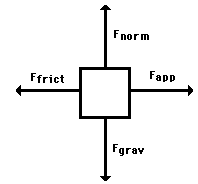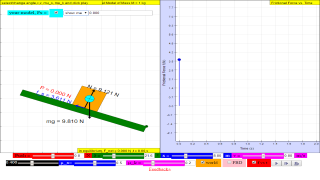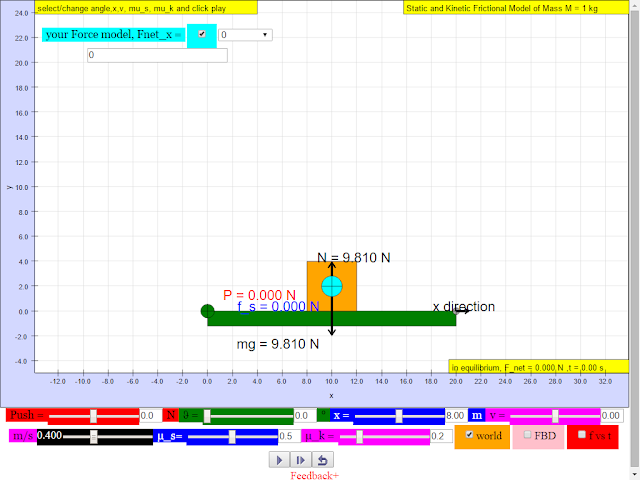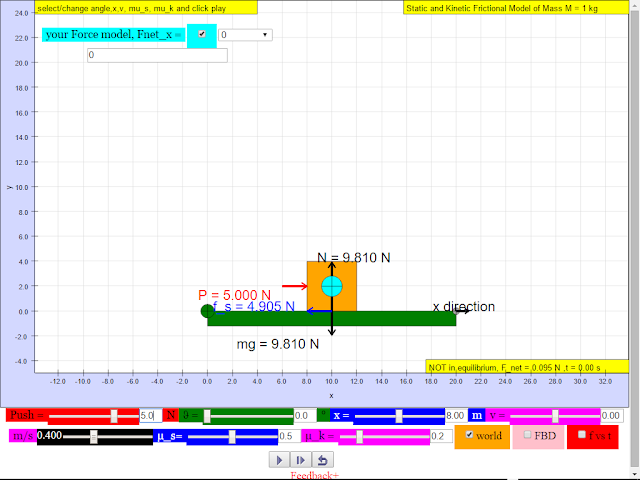About
http://weelookang.blogspot.com/2014/04/ejss-static-and-kinetic-friction-on.html
Translations
| Code | Language | Translator | Run | |
|---|---|---|---|---|
 |
||||
Credits

 This email address is being protected from spambots. You need JavaScript enabled to view it.; Francisco Esquembre
This email address is being protected from spambots. You need JavaScript enabled to view it.; Francisco Esquembre
Briefing Document: Frictional Model of Mass M = 1 kg JavaScript HTML5 Applet Simulation Model
1. Overview
This document analyzes an online educational resource from Open Educational Resources / Open Source Physics @ Singapore, specifically a JavaScript HTML5 applet simulating frictional forces on a 1 kg mass. The resource is designed to help students understand and visualize Newton's First and Second Laws of Motion through interactive modeling. It covers static and kinetic friction, the relationship between force and motion, and the concept of a net force. The model is accessible on various platforms (desktops, laptops, tablets, smartphones).
2. Key Themes and Concepts
- Newton's First Law (Law of Inertia): The resource uses thought experiments (coin on a card, a person stopping at a tape line) to illustrate that "an object will remain at rest or in uniform motion in a straight line unless acted upon by an external force." This is demonstrated when the coin stays in place when the card is pulled away quickly and when a person in motion cannot immediately stop.
- Quote: “an object will remain at rest or in uniform motion in a straight line unless acted upon by an external force.”
- Forces as Vectors: The simulation emphasizes forces as vector quantities, represented by arrows in diagrams. The length of the arrow indicates the magnitude of the force. This is used to show how different forces act on an object and how they can balance each other out, or result in a net force.
- Quote: "The length of the arrow tells us how strong a force is: the longer the arrow, the larger the force."
- Static and Kinetic Friction: The simulation explores the difference between static friction (force that prevents an object from moving) and kinetic friction (force that opposes the motion of an object). It is shown that static friction can increase to match an applied force up to a certain maximum, and once the object is moving, kinetic friction takes over. The simulation also highlights that kinetic friction usually has a lower magnitude than maximum static friction
- Quote: "...the static force is just a force to overcome initial when v = 0, after |v|>0, kinetic friction replaces as the frictional force."
- Net Force and Acceleration (Newton's Second Law): A primary learning outcome is that a non-zero net force causes an acceleration. This demonstrates Newton's Second Law (F=ma). The simulation allows students to manipulate the applied force (Push) and observe the resulting motion (or lack thereof), connecting the numerical relationships between force, mass and acceleration.
- Quote: "Thus, the evidences and model building process above suggests the condition of acceleration is the presence of non zero net force, which is F = ma, Newton's Second Law."
- Modeling and Simulation: The resource utilizes interactive modeling as a core teaching method. Students are actively involved in building and manipulating the model to understand physical principles. This is done by directly changing forces in the simulation and seeing what happens to the object as a result of the change.
3. Simulation Activities
The resource provides specific activities that are part of a learning progression to engage students with the concepts. These activities demonstrate the following:
- No Net Force (Fnet_x = 0): The simulation shows an object at rest remaining at rest. This directly demonstrates Newton's First Law.
- Quote: "Note the motion of the block is no change in position and velocity is zero all the time."
- No Net Force with Applied Force (0 < |Push| => Maximum Static Friction): This section explores static friction, demonstrating that the friction force will balance the applied push force up to a maximum value. The block doesn't move until the applied force exceeds the maximum static friction.
- Quote: "Note that the Push is cancel out by the Friction Force. Even at Push = 4.905 N is balanced out by Friction Force and the block does not move."
- Push Force Greater than Maximum Static Friction (Push > Maximum Static Friction): This activity shows how a force greater than the static friction's maximum will cause the object to move and that once in motion, kinetic friction replaces static friction as the friction opposing force.
- Quote: "But at t >0, the Friction becomes Kinetic Friction."
4. Learning Outcomes
The resource aims to help students:
- Explain phenomena related to objects at rest or in uniform motion, using modeling techniques.
- Predict changes in motion based on the forces acting on an object, also using modeling techniques.
5. Additional Features
- Moments/Torque Calculation: The simulation includes moments calculations which are used to determine the point of contact between the mass and the slope or surface and whether rotation occurs. This is shown when the object is positioned on a slope, that as the angle of the slope changes, the normal contact force shifts to the bottom end of the object, and at a certain point beyond the lower end of the object, rotation occurs.
- Accompanying Resources: The resource includes links to student worksheets, a video demonstrating a classic physics thought experiment, and blog posts explaining the model in more detail. These are intended to make the learning more flexible and engaging.
- Links to Other Simulations: The resource links to other interactive simulations related to force and motion from PhET and Andrew Duffy. This allows students to go beyond the specific scope of the current simulation and understand other related concepts
6. Misconceptions Addressed
- Constant Velocity and Applied Force: The resource explicitly addresses the misconception that an object moving at constant velocity requires a continuous applied push force. This is often a source of confusion because people experience friction in the real world and so may think that pushing is required to maintain a constant velocity, not accounting for the role of friction in the reduction of that velocity.
7. Technical Details
- The simulation is built using JavaScript and HTML5, making it accessible across various devices.
- The applet is embeddable on other web pages via an iframe.
8. Intended Audience:
This resource is primarily intended for students studying introductory physics and dynamics, specifically for teaching of Newton's Laws of Motion and the concept of friction.
9. Conclusion
The "Frictional Model of Mass M = 1 kg" simulation is a valuable interactive tool for teaching fundamental concepts in physics. Its focus on active modeling and visualization, combined with clear explanations of static and kinetic friction and the importance of net force on motion, makes it an effective educational resource for students learning about dynamics and Newton's Laws. The inclusion of related materials like worksheets and videos supports a multi-faceted learning experience.
Frictional Model Simulation Study Guide
Quiz
Instructions: Answer the following questions in 2-3 sentences each.
- According to Newton’s First Law, what conditions are necessary for an object to remain at rest or in uniform motion?
- In the “Pre Modeling Activity,” what do the length of arrows representing forces indicate?
- In the "No Net Force (no Push Force) Model," what happens to the block's position and velocity?
- In the "No Net Force (0<|Push|=>Maximum Static Friction) Model," why does the block not move initially when pushed?
- What happens to the frictional force once the applied push force is greater than the maximum static friction?
- What is the key idea about acceleration that the model-building process suggests?
- What is a common misconception about objects moving with constant velocity that students may have?
- According to the added moment calculations, what happens when the angle of a block on a slope is greater than 45 degrees?
- Name one resource, aside from this source material, that is suggested for further study on forces and motion.
- What is the name of the tool used for creating the simulations mentioned in the source material?
Quiz Answer Key
- Newton’s First Law states that an object will remain at rest or in uniform motion in a straight line unless acted upon by an external force. This means that if no net force acts upon an object, it will maintain its current state of motion.
- The length of the arrows indicates the magnitude or strength of the force. Longer arrows represent larger forces, while shorter arrows represent smaller forces.
- When no push force is applied and Fx = 0, the block's position remains unchanged and its velocity is zero throughout the simulation. There is no movement.
- The block does not move because the applied push force is counteracted by an equal and opposite static frictional force. This opposing friction force prevents the block from moving up to a certain maximum point.
- Once the applied push force exceeds the maximum static friction, the block begins to slide, and the static friction is replaced by kinetic friction, which is typically smaller.
- The model suggests that acceleration occurs when there is a non-zero net force acting on the object, which aligns with Newton's Second Law (F=ma).
- Students may incorrectly believe that an object requires a continued push to move with a constant velocity and that it is still experiencing a net force in the direction of movement, when this is not the case.
- If the angle of a block on a slope exceeds 45 degrees, the normal contact force shifts beyond the block's edge causing the block to rotate clockwise (though this specific rotation is not shown in the simulation).
- PHET's "Forces and Motion" simulation is suggested as an additional resource.
- Easy JavaScript Simulation (EJS) is the tool used for creating the interactive physics models and simulations.
Essay Questions
Instructions: Develop a multi-paragraph essay to answer the following questions.
- Explain the concepts of static and kinetic friction and how they are demonstrated in the simulation. How does the simulation help clarify the differences between the two types of friction?
- Discuss how the "Frictional Model of Mass M = 1 kg" simulation provides evidence for Newton's First Law of Motion. How does this simulation connect to the idea of inertia?
- Using the information from the source material, explain how the simulation models Newton’s Second Law of Motion (F=ma). Discuss how the concepts of net force and acceleration are demonstrated.
- Describe the different stages of the simulation and how they build understanding of the different situations involving frictional forces. Discuss the progression of activity types in the simulation and the learning goals.
- Critically evaluate the effectiveness of using simulation models in teaching physics concepts like friction, as illustrated by this resource. What are the strengths and limitations of using simulations for instruction?
Glossary of Key Terms
Net Force: The overall force acting on an object, which is the vector sum of all individual forces. A non-zero net force causes acceleration.
Static Friction: A force that resists the start of motion between two surfaces in contact. It increases with an applied force up to a maximum limit and will keep an object at rest.
Kinetic Friction: A force that opposes the motion of two surfaces in contact when they are sliding against each other. It is typically less than static friction.
Newton’s First Law of Motion (Law of Inertia): An object at rest stays at rest, and an object in motion stays in motion with the same speed and in the same direction unless acted upon by a net external force.
Newton's Second Law of Motion: The acceleration of an object is directly proportional to the net force acting on it and inversely proportional to its mass (F=ma).
Inertia: The tendency of an object to resist changes in its state of motion. Objects with more mass have more inertia.
Modeling: A technique used to represent real-world phenomena through diagrams, mathematical equations, or other representations to explain, predict, and analyze behavior.
Simulation: A computer-based program or model that emulates real-world processes and allows users to interact and observe.
Moments (Torque): A measure of the tendency of a force to cause rotation about an axis. It is the product of the force and the perpendicular distance from the line of force to the axis of rotation.
Learning Outcomes
- To explain and understand phenomena when there is no net force acting on a stationary object, or on an object that is moving in a straight line using modelling technique [diagrammatic models, mathematical models (dynamics equations), or any set of predictive and explanatory rules/principles].
- To predict changes in motion (if any) of an object based on the forces acting on it using modelling technique [diagrammatic models, mathematical models (dynamics equations), or any set of predictive and explanatory rules/principles].
Worksheet
- Dynamics - student worksheet (gwf - dl - wlk).docx
- Dynamics - student worksheet (gwf - dl).docx
- Dynamics - student worksheet (lyna).docx
Video
Frictional force modelling with simulation activity by lookang lawrence wee
Imagine you put a playing card on top of a cup, then a coin on top of the playing card. Quickly pull the playing card away. What will happen to the coin? Explain your answer. Watch the video at http://tinyurl.com/ast2016-1 and check your prediction
Newtons 1st Law-coin and glass by Nick Alsleben
Engage for Newton's 1st Law
Imagine placing a strip of tape on the floor. Then you ask a friend to run towards you from about 30 meters as fast as possible and to stop exactly on the tape. What will happen to your friend when he or she tries to stop? Explain your answer
Suggested answer:
What you demonstrated in your two thought experiments, is Newton’s First Law. It states that
“an object will remain at rest or in uniform motion in a straight line unless acted upon by an external force.”
In case 1 (video above), the coin stayed in place, as the card was pulled away so fast, that friction did not act. In case 2 (engage for newton's 1st law), your friend had some forward motion, that could not be removed immediately.
Pre Modeling Activity
In this activity, you will be asked to draw forces in diagrams. Forces are usually indicated by arrows. The length of the arrow tells us how strong a force is: the longer the arrow, the larger the force.
In the example, we see two vertical forces acting on a Wooden Block resting on a slope. Its Fgrav= Weight is pulling it down and Fnorm = contact force on block by slope, an upward force. The Ffrict is the frictional force arising when there is a Fapp = Push to the right. The fact that the arrows are equally large, tells us that the two forces have the same magnitude. 
Modeling Activity
Modeling Activity using this #html5 simulation
No Net Force (no Push Force )Model
Tom has just been promoted and is pushing a file cabinet down the hall to his new office. He begins by looking at the file cabinet and considers how to best go about his task. Select Fx = 0 to model the zero force model. Note the motion of the block is no change in position and velocity is zero all the time.
Activity 1: Using the model builder, select Fnet_x = 0 to simulate this effect
No Net Force ( 0<|Push| => Maximum Static Friction) Model
He then begins pushing on the file cabinet, which, at first, does not move at all. To simulate this case, select Push to be 3 N and observe what happens to the motion of the block. Note that the Push is cancel out by the Friction Force. Even at Push = 4.905 N is balanced out by Friction Force and the block does not move.
Activity 2: Using the model builder, select Fnet_x = 0 to simulate this effect
Just Enough Push force (Push> Maximum Static Friction) to move Model
He pushes it slightly harder than the maximum static friction, and it is sliding . Thus, applying a Push force just larger than 4.905 N, the object begins to slide. But at t >0, the Friction becomes Kinetic Friction.
Eventually the file cabinet begins to slide across the floor, slowly moving towards his new office with acceleration.
Activity 3: Using the model builder, select Fnet_x = 3.038 to simulate this effect. note that the static force is just a force to overcome initial when v = 0, after |v|>0, kinetic friction replaces as the frictional force.
Big Idea
Thus, the evidences and model building process above suggests the condition of acceleration is the presence of non zero net force, which is F = ma, Newton's Second Law.
Misconceptions
Students may think that it is possible to experience is pushing the file cabinet, and it is moving to the right with constant velocity.
Added Moments Calculations
as suggested by workshop participant from JJC, moments are calculated and reflected in simulation!
 |
| angle = 0, block does not rotate https://sg.iwant2study.org/ospsg/index.php/interactive-resources/physics/02-newtonian-mechanics/02-dynamics/42-friction |
 |
| angle = 45, block does not rotate, normal contact force shifts to the extreme lower end of the block, just in position to not rotate clockwise.https://sg.iwant2study.org/ospsg/index.php/interactive-resources/physics/02-newtonian-mechanics/02-dynamics/42-friction |
 |
| angle > 45, block rotates (but not simulated), normal contact force shifts beyond the extreme lower end of the block, in real life, block will rotate clockwise.https://sg.iwant2study.org/ospsg/index.php/interactive-resources/physics/02-newtonian-mechanics/02-dynamics/42-friction |
Versions
- http://weelookang.blogspot.sg/2016/02/frictional-block-free-body-diagram-with.html BlogPost by lookang with added moments calculations.
- http://weelookang.blogspot.com/2014/04/ejss-static-and-kinetic-friction-on.html BlogPost by lookang
- Sliding Down an Incline Plane Model by Francisco Esquembre http://www.compadre.org/osp/items/detail.cfm?ID=9973
Other Resources
- http://phet.colorado.edu/en/simulation/legacy/forces-and-motion Forces and Motion by PHET
- http://physics.bu.edu/~duffy/HTML5/static_friction.html Exploring static friction by Andrew Duffy
FAQ: Frictional Model Simulation
1. What is the primary focus of this simulation model?
The primary focus of this simulation is to model and demonstrate the effects of frictional forces on a 1 kg mass, illustrating key concepts from Newton's Laws of Motion, specifically the first and second laws. It allows users to visualize and explore how forces interact to affect an object's state of rest or motion, focusing on static and kinetic friction.
2. What are the main learning outcomes associated with this simulation?
The learning outcomes are twofold: firstly, to explain the phenomena of objects at rest or in uniform motion in a straight line when there is no net force acting upon them. This involves understanding how different models, like diagrammatic and mathematical models, can predict and explain these scenarios. Secondly, the learning outcome is to predict changes in motion based on forces and the simulation tools for such modelling.
3. How does the simulation model the concept of "no net force"?
The simulation models "no net force" in two contexts: Firstly, where no push force is applied, and the block remains stationary with zero velocity and no change in position. Secondly, when the push force is less than the maximum static friction. Here, the applied force is exactly counterbalanced by the frictional force, resulting in no net force. In both cases the object does not move. The simulation visually demonstrates the balance of forces in these scenarios.
4. How does the simulation illustrate the difference between static and kinetic friction?
The simulation distinguishes static and kinetic friction by demonstrating that a certain amount of force (up to the maximum static friction) can be applied without causing movement. Once the applied force exceeds this maximum static friction, the block begins to slide and kinetic friction (which is a different and constant value) comes into play, allowing users to observe the change in the frictional force once the block is in motion.
5. How is Newton's First Law demonstrated using the simulation or in the associated examples?
Newton's First Law, which states that an object will remain at rest or in uniform motion unless acted upon by an external force, is demonstrated through several examples including the simulation itself. The simulation when no push force is applied shows an object staying at rest. The example of the coin on the playing card pulled away and the friend running and then stopping, demonstrates that an object tends to maintain its current state of motion or rest.
6. How does this simulation connect to Newton's Second Law?
This simulation connects to Newton’s Second Law (F=ma) by emphasizing that acceleration occurs when there is a non-zero net force acting on an object. The simulation shows that once the applied push force exceeds the maximum static friction, the block begins to accelerate. The acceleration can be varied by changing the net force which corresponds to different applied force amounts.
7. Can the simulation demonstrate the concept of moments, and how does this relate to block rotation?
Yes, the simulation incorporates moments calculations, which are crucial for understanding rotational effects. This is illustrated with the block on an incline, showing that as the angle increases, the normal contact force shifts until it eventually causes the block to rotate clockwise. This feature visually links forces, their point of application, and rotational tendencies. It is not simulated in the primary simulation model.
8. Who developed this simulation and what are some other resources related to this model?
This simulation was developed by Open Educational Resources / Open Source Physics @ Singapore. The credits indicate that Francisco Esquembre is also associated with the development. Additional resources include blog posts by lookang and models by Francisco Esquembre
- Details
- Parent Category: 03 Motion & Forces
- Category: 02 Dynamics
- Hits: 7504














